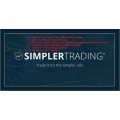Stop Loss Matters (Total size: 14.50 GB Contains: 7 folders 57 files)
 Click to enlarge |
|
A breakeven stop will help lock in a no-loss trade. Once a trade is begun and there is little threat of your initial stop being hit, yiur stop loss can be moved up to breakeven to ensure no-loss is made on a trade.
Especially with the application of leverage, it is important to move your stop to breakeven as soon as reasonably possible. This will minimise the potential drawdown of your account.
At least when you have moved your stop to breakeven, there is a chance that you will end up with a profitable trade.
Average True Range (ATR) is a measure of volatility and market noise introduced by Welles Wilder in his book: New Concepts in Technical Trading Systems. It’s an indicator of the tendency of a security to move, in either direction.
More specifically, the average true range is the (moving) average of the true range for a given period. The true range is the greatest of the following:
• The difference between the current high and the current low
• The difference between the current high and the previous close
• The difference between the current low and the previous close
The value returned by the average true range is simply an indication as to how much a stock has moved either up or down on average over the defined period. High values indicate that prices are changing a large amount during the day. Low values indicate that prices are staying relatively constant. ATR does not indicate a trending or ranging market.
Once the ATR is calculated, a multiple of this value can be deducted from your entry price and used as stop loss. Examples of this multiple for a stop are usually 2xATR and 3xATR depending on your trading method and risk. The greater the number of ATRs, the wider your stop, and the more willing you are to let prices swing before declaring a change in trend.
Example
Entry $2.00 with ATR of $0.10 (stop loss at 2xATR would be $1.80)
Once entering using this method your stop loss should never be moved down. It should either remain at the current level, or move up with the ATR and price action.
Example
Entry $2.00 with ATR of $0.10 (stop loss at 2xATR would be $1.80)
Current Price 1.90 with ATR of $0.09 (stop loss at 2xATR would remain at $1.80)
Current Price 2.10 with ATR of $0.12 (stop loss at 2xATR move up to at $1.86)
The Guppy Count Back Line (CBL) is a support/resistance line, calculated using end of day data. It has applications in trading in both entry and exiting a trade. The CBL is not to be used as a standalone tool and should be used in conjunction of other tool like GMMA or a simple trend line.
Applications of the CBL include
• an indication of the potential end of a downtrend
• an entry trigger
• a protect capital stop loss trigger
• a protect profit exit trigger
• a guide point for setting a maximum chase price
The CBL is calculated using the cumulative range value of three higher days. This means the calculation point for the CBL line might be 5, 10, 15, 30 days away from today’s date.
The Value of the CBL only changes when a new higher high is made and only then if the stop price rises. When using the CBL as a stop, we never lower it.
Calculation of the CBL is as follows
1. Use latest peak high as start point
2. Ignore higher lows as you count back
3. Draw CBL stop loss line @ 3 lows down
4. Include low of start point and gaps
5. Move up CBL as share reaches higher peaks
6. If 2 peaks at same price, use the one that gives highest CBL
7. Exit day after closes below 3 day CBL
8. Beware of selling near trend line support
9. But definite exit confirmation if closes below trend line and 3 day CBL
A stop order is an order entered by a trader to buy (or sell) a security once the price of the security climbed above (or dropped below) a specified stop price. These orders are triggered automatically your broker at market price, which means your broker buys (or sells) the stock at the best market price available immediately.
Stop loss orders are a great tool to take the emotion out of a selling. They allow the trader to pretermine the sale price allowing the trader the freedom not to actively monitor a trade, and not hold onto positions once they fall below the stop loss level.
They can also be used as emergency exit by setting the price below your intended stop. This emergency stop will then only be trigger if a major financial setback occurs in the security.
Advantages
Don't have to monitor on a daily basis how a stock is performing
Emotion removed out of stop loss
Can be used as an emergency exit
Can be set as multiple stops for a longer-term position so that you won’t get shaken out on a small dip
Disadvantages
Stop price could be activated by a short-term fluctuation in a stock's price
Stop loss is entered as a market order which may be much different from the stop price
Losses are a part of trading and investing. Small losses are the key to long-term success.
From Wikipedia
A sell stop order is an instruction to sell at the best available price after the price goes below the stop price. A sell stop price is always below the current market price. For example, if an investor holds a stock currently valued at $50 and is worried that the value may drop, he/she can place a sell stop order at $40. If the share price drops to $40, the broker will sell the stock at the next available price. This can limit the investor's losses (if the stop price is at or below the purchase price) or lock in some of the investor's profits.
A buy stop order is typically used to limit a loss (or to protect an existing profit) on a short sale.[3] A buy stop price is always above the current market price. For example, if an investor sells a stock short hoping the stock price goes down in order to give the borrowed shares back at a lower price (Covering), the investor may use a buy stop order to protect himself against losses if the price goes too high.
A stop-limit order combines the features of a stop order and a limit order. Once the stop price is reached, the stop-limit order becomes a limit order to buy (or to sell) at no more (or less) than a specified price.[4]
As with all limit orders, a stop-limit order may not get filled if the security's price never reaches the specified stop price.
A trailing-stop order is an order entered with a stop parameter that creates a moving or trailing activation price, hence the name. This parameter is entered as a percentage change or actual specific amount of rise (or fall) in the security price. Similarly a trailing-stop-limit order could be entered. Few brokerage firms will accept these orders as they must continuously keep track of the stock price and adjust the stop level
(unlimited download and permanent access to cloud server) (Buyer will be gain permanent access to the cloud storage files,Proof of content,please see the images)
Delivery to your PayPal email address within 24 Hours of payment confirmation.
Completing units:
![]() Stop Loss Matters (Total size: 14.50 GB Contains: 7 folders 57 files)
Stop Loss Matters (Total size: 14.50 GB Contains: 7 folders 57 files)
To buy without signing in contact us here:
Market Sales Price: $299,but we sell lot more lower than that to share the opportunity with you!
Our Policies
A. Product Quality
- We ensure that the quality of the course is good, and we update them regularly to help you keep update.
- If there is a problem you can not use, please let us know so we can fix it soon or if there is any notification, we will inform you immediately.
B. Shipping Method
- After receiving your payment, we will send you a link to access and download the course. If our team is not in the office, please wait for us about 8 hours to come back.
C. Refund Policy
We do not accept refund after you got the link and download the course.
We will refund your money in case of:
- Item is not as described
- Item doesn’t work the way it should
- Item support extension can’t used
Serving Professional Traders Since 2008
Once purchased I will email you the files within 20 minutes and not more than 48 hours to your email, if there a delay, please be patience receiving your files
Your Review: Note: HTML is not translated!
Rating: Bad Good
Enter the code in the box below:

 Categories
Categories Information
Information Specials
Specials




-38x38.jpg)

-38x38.jpg)
-38x38.jpg)
-38x38.jpg)
-38x38.jpg)
-38x38.jpg)

-38x38.jpg)



-38x38.jpg)


-38x38.jpg)
-38x38.jpg)
-38x38.jpg)
 Featured
Featured

























 Shopping Cart
Shopping Cart Bestsellers
Bestsellers






-38x38.jpg)































-38x38.jpg)














![[Video Course] ChatGPT Secrets: Beginner to ChatGPT Ninja w/ 700+ Prompts (49 Lectures, 4 hours+ Video Tutorial) [Video Course] ChatGPT Secrets: Beginner to ChatGPT Ninja w/ 700+ Prompts (49 Lectures, 4 hours+ Video Tutorial)](https://www.missionforex.com/image/cache/data/th7064-120x120.jpg)


-120x120.jpg)
-120x120.jpg)
